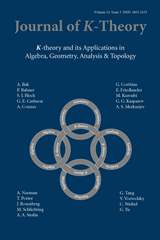Article contents
Representability of derived stacks
Published online by Cambridge University Press: 31 January 2012
Abstract
Lurie's representability theorem gives necessary and sufficient conditions for a functor to be an almost finitely presented derived geometric stack. We establish several variants of Lurie's theorem, making the hypotheses easier to verify for many applications. Provided a derived analogue of Schlessinger's condition holds, the theorem reduces to verifying conditions on the underived part and on cohomology groups. Another simplification is that functors need only be defined on nilpotent extensions of discrete rings. Finally, there is a pre-representability theorem, which can be applied to associate explicit geometric stacks to dg-manifolds and related objects.
Keywords
- Type
- Research Article
- Information
- Copyright
- Copyright © ISOPP 2011
References
- 8
- Cited by


